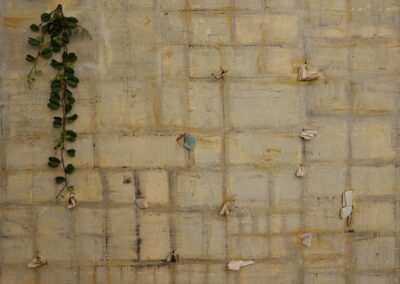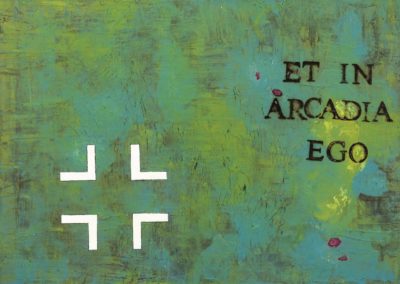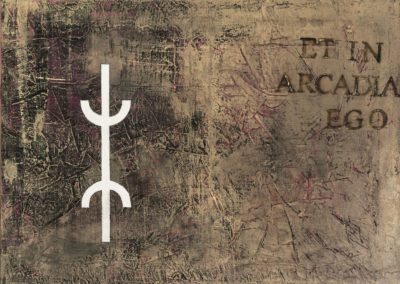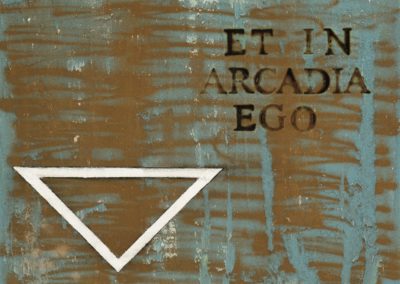FEOFEO was born in Alessandria in 1969. Her way to art does not follow any academic route, but she proved to be looking for symbols to communicate with the soul....READ MORE ↴
Feofeo, was born in Alessandria in 1969.
Her way to art does not follow any academic route, but she proved to be looking for symbols to communicate with the soul.
From quantic study along with some theories about the use of colours by Goethe and later by Steiner helped to reach new representations of primitive archetypes, cinetic lines of radiant energy and golden spirals.
Her emancipated art is a hymn to the moods expressed by those who paint and the beholder.
The artist, as a seductress of thoughts, allows the colours on the canvas to change as well as you change your feelings in a stylistic grammar where not following the rules is the fundamental attitude and letting the soul free go is the key verb.
The kind of artistic research she is going through is not aiming to reality or to what surrounds us. On the contrary, it goes deep in the soul, into the deepest and most unknown places of the conscience, namely opening up to endless possibilities of interpretation and perception.
What Feofeo is trying to transfer on the canvas is the strong desire to go deeper into the soul, to reach a far complex inner dimension, where everything can be repeated and occur endlessly, both in the microcosm and in the macrocosm, below, as well as above.
Since 2011 some of her works have been exhibited in museums and galleries in all Italy as well as abroad in the city of Barcelona, Berlin, Brussels, Bratislava, Buenos Aires at the “Honorable Camara de Senadores”, Los Angeles, Lugano, Montecarlo, Obernberg, Oslo, Saint Petersburg, Stokolm and Tallinn and in art fairs of Miami, New York and Paris.
In the year 2016, her first monograph “i am colour” signed by Giovanni Faccenda, art critic and historian and TV presenter, is published by Editoriale Giorgio Mondadori. The monograph includes 170 works and it displays them according to a metaphorical 3 – part division as for Feofeo Monography, i.e. Enlightenment, Beyond and The great Opera.
The last cycle of new artworks painted between the end of 2018 and the beginning of 2019, revolves around a wording that explains studies and explanations that have not yet found a unique decoding: ET IN ARCADIA EGO.
The new cycle focused on the esoteric theme that, with respect to the past, it enters more and more inside its canvases enriching itself with arcane essences belonging to the Priory of Sion, to the Templars up to the theses of the philosopher René Guénon that enhances her painting even more.
In 2024 the artist was invited to exhibit in the The Perceptive Group section at the 60th International Art Exhibition – La Biennale di Venezia, Grenada Pavilion, curated by Prof. Daniele Radini Tedeschi with an interactive work with a highly symbolic connotation entitled “The Wall of Wishes”.
The work depicts that sacred place which is the Western Wall of Jerusalem made with limestone mortar to represent the stones of Herod’s period and the fire burns to create the cracks caused by time.
Every believer, belonging to any religion, can go to the Wailing Wall and place a message there, inserting a paper note to be given to fate.
The tickets, after having stayed on the wall, will be transferred to the Mount of Olives and never destroyed, they will bring their prayers to everyone’s God.
On the left side of the work is the caper plant which thrives on the wall of Jerusalem and symbolizes life.
Accompanying the pictorial work is music and the latter takes its voice with the representation of Beethoven’s Ninth, played by the Divan Orchestra, which brings together young musicians from all the countries of the Middle East (Israel, Egypt, Jordan, Syria, Lebanon and Palestine).
In the same year the artist exhibited his new cycle at the Jewish Museum Complex of Casale Monferrato, in the exhibition entitled Semantic Vibrations curated by Prof. Ermanno Tedeschi.
In this last journey the artist associates the 22 letters of the Hebrew alphabet with numerology. Scholars of Jewish texts recognize the long-standing practice in ancient traditions of counting the number of times a given word, phrase, number, paragraph, or letter appears in the Scriptures.
Ghematria places importance on numbers and letters in providing information about words and concepts in the sacred text itself, in other words it looked for what was written “between the lines” identifying patterns, codes and repetitions.
Ghematria is the language of God hidden in the texts of the sacred scriptures.
Numerical sequences, hidden codes, equidistant letters, recurring phrases signifying that beneath the words that make-up our sacred texts lies a world of deeper knowledge just waiting to be discovered.
The artworks by Feofeo are both in Italy and abroad as part of public and private collections and her quotations are published in the Catalogue of Modern Italian Art, by Editioriale Giorgio Mondadori where Feofeo is included into the “IS” category for her national and international recognition by some well-known criticism.




